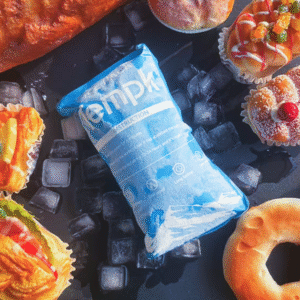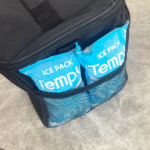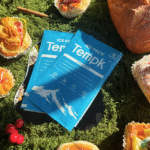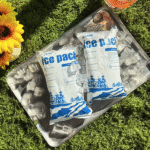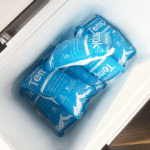Is dry ice better than gel ice packs for cold chain shipping?
Shipping perishable goods requires careful temperature control. Many shippers wonder "Is dry ice better than gel ice packs?» for keeping products safe. La glace carbonique fournit des températures ultra froides (around –109.3 °F) and is ideal for long distance frozen shipments. Packs de glace en gel, d'autre part, maintain moderate cooling between 2–8 °C, making them suitable for items that must not freeze. This guide compares their performance, sécurité, coût, durabilité, and trends to help you choose the best cooling solution.
What distinguishes dry ice from gel ice packs? Learn about their composition, temperature ranges and when each is appropriate.
Which option is safer and easier to handle? Discover handling precautions and regulatory requirements.
How do cost and environmental impacts compare? Evaluate long term expenses and sustainability considerations.
Que sont les 2025 trends in cold chain cooling solutions? Explore innovations like phase change materials and smart sensors.
What distinguishes dry ice from gel ice packs?
Dry ice and gel ice packs differ fundamentally in composition and temperature performance. Dry ice is solid carbon dioxide that sublimates directly into gas at –78.5 °C (–109,3 ° F), delivering extreme cold for shipments that must remain frozen. Gel ice packs contain water or phase change materials that freeze near 0 °C and slowly absorb heat as they melt, maintaining moderate temperatures. This distinction makes dry ice ideal for products like ice cream, viandes surgelées, ou spécimens biologiques, while gel packs suit fresh produce, dairy products and pharmaceuticals requiring 2–8 °C.
Understanding their properties and uses
Both cooling methods rely on phase change, but they work differently:
| Aspect | Glace sèche | Packs de glace en gel | Ce que cela signifie pour vous |
| Composition | Solid carbon dioxide sublimates directly into CO₂ gas | Water based gel or phase change materials freeze near 0 °C | Dry ice yields extreme cold; gel packs offer moderate, refroidissement stable |
| Plage de température | Provides ultra low temperatures (–78.5 °C/–109.3 °F) | Maintains 2–8 °C for up to 48 h | Choose dry ice for items needing deep freezing; packs de gel pour produits réfrigérés |
| Durée | Can keep items frozen for several days with proper insulation | Holds temperature for 24–48 h depending on pack size and insulation | Dry ice lasts longer but depends on container insulation; gel packs suit short shipments |
| Manutention | Requires insulated gloves, pinces, and ventilation due to frostbite risk | Sûr à manipuler, aucun équipement spécial n'est nécessaire | Consider user safety and training in your operations |
| Règlements | Classified as a hazardous material; shipping requires labeling, weight limits and ventilation | Generally unregulated and easier to ship | Compliance affects cost and logistics planning |
Dry ice’s sublimation and extreme cold make it indispensable when you must keep products frozen solid. Cependant, its handling risks and regulatory requirements mean it isn’t always the best solution.
Explaining dry ice vs gel ice packs in simple terms
Imagine a road trip where you need to keep ice cream frozen and sandwiches cool. Dry ice is like a portable deep freezer—it keeps ice cream rock solid for days but needs careful handling so you don’t “burn” yourself or fill the car with CO₂ gas. Gel ice packs are like a refrigerator pack—they keep sandwiches cold and safe without freezing them. They’re easier to handle, réutilisable, and won’t give you a frostbite if you accidentally touch them. This analogy captures why the choice depends on what you’re shipping and how long it needs to stay cold.
Why is dry ice considered hazardous compared to gel ice packs?
Safety risks and regulatory requirements
Dry ice’s extreme cold and CO₂ release create unique hazards. Direct contact with bare skin can cause frostbite-like burns. When sealed in airtight containers, the sublimating CO₂ gas can build pressure and cause explosions, which is why shipping carriers require vented packaging and strict labeling. Many couriers restrict dry ice quantities and require Class 9 hazardous material labels, special documentation and weight limits. Because of these hazards, packages containing dry ice must remain vented and cannot be shipped through some services.
Par contre, gel ice packs pose minimal risks. They are typically non toxic, do not sublimate, and are safe to handle without protective gear. There are no special regulatory requirements for shipping gel packs, making them more accessible for consumers and small businesses.
Practical safety tips for handling dry ice and gel packs
Portez un équipement de protection: Always use insulated gloves and tongs when handling dry ice.
Assurer la ventilation: Pack dry ice in a well ventilated container to avoid CO₂ buildup.
Use the right container: Never use an airtight container with dry ice, as pressure may build up. Pour les packs de gel, choose a container sized to allow adequate cushioning and cold circulation.
Limit weight: Follow guidelines for dry ice quantity—equal weight to the payload for 48 hour shipments or 1.5 times the payload for 72 hour shipments.
Monitor conditions: Use temperature sensors to track internal temperatures. When using gel packs, replace them if they become too warm or heavy with condensation.
Cas pratique: A meal-kit company switched from dry ice to gel packs for overnight deliveries after several customers experienced foggy packaging and frostbite from touching dry ice pellets. The switch eliminated hazards, reduced customer complaints, and simplified shipping compliance without compromising quality.
When is dry ice better than gel ice packs?
Comparing performance for different product categories
Performance depends on the temperature requirements and sensitivity of your products:
Frozen foods and frozen pharmaceuticals: Dry ice is unmatched for preserving items that must remain below freezing. Products like ice cream, viandes surgelées, or sensitive vaccines require ultra cold temperatures and long transport durations. Dry ice can maintain these temperatures for several days when combined with high quality insulation.
Chilled perishables and medications: Gel ice packs maintain a stable 2–8 °C environment, which is ideal for fresh produce, produits laitiers, floral shipments, et produits pharmaceutiques qui ne doivent pas geler. Gel packs also prevent the “freezer burn” or texture changes that can occur when products partially freeze.
Livraisons aux consommateurs: For meal kits and groceries delivered locally, gel ice packs provide safe handling, élimination facile, et réutilisabilité. Dry ice may over cool items, causing liquids to freeze or packaging to crack.
Tableau: Ideal applications of dry ice vs gel ice packs
| Shipment type | Dry ice use | Gel ice pack use |
| Aliments surgelés (glace, fruit de mer) | Necessary for deep frozen temperature stability | Not recommended; cannot reach sub zero temperatures |
| Produits frais, laitier, médicaments | May over freeze and damage products | Recommended for stable 2–8 °C cooling |
| Long distance shipments (48–72 h) | Effective when combined with proper insulation, using equal or greater weight of dry ice than product | Limité; may require multiple gel packs and insulation |
| Consumer-friendly deliveries (kits de repas) | Handling risk and CO₂ gas make it less suitable | Sûr, reusable and easy to handle |
| Biological samples and laboratory research | Preferred due to ultra low temperatures and extended duration | Inadequate; may allow samples to thaw |
Conseils et recommandations d'utilisation
Tailor your solution: Consider product sensitivity, travel distance, et température requise. Use dry ice for deep frozen items and gel packs for chilled goods.
Combine methods when necessary: For shipments that need both cooling ranges, a hybrid approach using gel packs near temperature-sensitive items and dry ice for overall coldness can provide balanced temperatures.
Invest in quality insulation: The performance of both dry ice and gel packs depends heavily on the insulation of the container. High performance liners, sacs isolés de glace carbonique, or vacuum-insulated panels help maintain the desired temperature longer.
Cas pratique: A seafood exporter shipping crab across the country combined dry ice and gel packs. Gel packs surrounded the crab meat to avoid freezer burn, while dry ice placed on top maintained the overall sub zero environment. This hybrid method preserved texture and ensured regulatory compliance.
What are the cost and environmental considerations?
Comparing costs and reuse potential
Dry ice costs more and is single-use, while gel packs offer longer-term value. Dry ice is a consumable product; its cost includes purchase, stockage, manutention, and compliance fees. It sublimates completely during shipment and must be replaced for each use. Gel ice packs cost less per use, can be bought in bulk, and are reusable—reducing long-term expenses. Their cost-effective nature is especially important for businesses that ship frequently or offer subscription services.
| Facteur | Coût de la glace carbonique | Gel ice pack cost | Qu'est-ce que cela signifie |
| Purchase price | Coût initial plus élevé | Lower cost per unit and available in bulk | Gel packs lower upfront spending |
| Réutilisabilité | À usage unique; sublime complètement | Réutilisable; can be refrozen many times | Reusability lowers long-term costs |
| Shipping compliance fees | May include hazardous materials surcharges and documentation | No special fees or labeling requirements | Gel packs simplify logistics |
Environmental impacts and sustainability
Glace sèche: Although dry ice sublimes into CO₂—a by product of industrial processes—it still contributes to greenhouse gas emissions when produced and transported. Its manufacturing can be energy intensive. Disposal requires safe venting, and CO₂ emissions must be managed.
Packs de glace en gel: Many modern gel packs use biodegradable or recyclable materials and can be refrozen repeatedly. Reusability reduces waste and energy consumption. Cependant, older gel packs may contain plastics that need proper recycling.
For eco conscious businesses, gel ice packs often align better with sustainability goals. Encore, choosing sustainably sourced dry ice produced from captured CO₂ can reduce the environmental impact of using dry ice.
Practical suggestions for cost and sustainability
Conduct a cost analysis: Calculate your annual shipment volume, required cooling duration, and labor costs for handling and compliance. Determine whether the higher performance of dry ice offsets its cost and regulation.
Implement reusable programs: Offer return or reuse programs for gel packs to reduce waste and encourage customers to return them.
Opt for eco-friendly dry ice: Lorsque vous utilisez de la glace sèche, source it from suppliers that capture CO₂ from industrial emissions and invest in renewable energy for production.
Cas pratique: A biotechnology firm shipping temperature-sensitive enzymes switched from dry ice to reusable phase-change gel packs and insulated boxes. Their analysis showed a 30 % reduction in packaging costs over a year and a significant decrease in carbon footprint by eliminating weekly dry ice deliveries.
2025 trends and innovations in cold chain cooling solutions
Emerging technologies and materials
À mesure que la logistique de la chaîne du froid évolue, innovations aim to bridge the performance gap between dry ice and gel ice packs. Les principales tendances comprennent:
Matériaux à changement de phase (PCMS): Advanced gel packs now incorporate PCMs that freeze at specific temperatures, extending cooling durations and providing more precise temperature control. These PCMs allow gel packs to maintain stable temperatures for 48–72 hours.
Capteurs intelligents et intégration IoT: Many insulated containers now include sensors that monitor temperature, humidité, and transit conditions, sending real time data to shippers. This allows proactive adjustments and reduces spoilage.
Systèmes de refroidissement hybrides: Combining gel packs and dry ice in the same shipment to provide multiple temperature zones is becoming more common, offering flexibility for diverse products.
Matériaux écologiques: Manufacturers are developing gel packs with biodegradable casings and using recycled CO₂ for dry ice production, aligner les objectifs de durabilité.
Market insights and growth
The cold chain logistics market is expected to grow by around 10 % chaque année à travers 2025. Drivers include the expansion of e commerce meal kits, vaccines requiring ultra cold storage, and global demand for fresh produce year round. En même temps, environmental regulations and consumer expectations push companies toward sustainable, reusable cooling solutions. Recyclable packaging for dry ice and hybrid cooling methods combining gel packs and dry ice are gaining traction.
Questions fréquemment posées (FAQ)
Q1: Is dry ice better than gel ice packs for shipping frozen food?
Dry ice provides much colder temperatures and lasts longer than gel ice packs, making it ideal for frozen foods such as ice cream, viande, ou échantillons biologiques. Cependant, proper handling and compliance with hazardous material regulations are essential.
Q2: When should I choose gel ice packs instead of dry ice?
Choose gel ice packs for products that must stay cool (2–8 ° C) but not freeze, comme les produits frais, produits laitiers, or vaccines sensitive to freezing. They are safer to handle and reuse, reducing cost and environmental impact.
Q3: Can I combine dry ice and gel ice packs in one shipment?
Oui, using both can provide layered temperature control. Gel packs can protect products from direct contact with dry ice, prévenir les brûlures de congélation, while dry ice maintains overall freezing conditions.
Q4: Are there regulations for shipping dry ice?
La glace sèche est classée comme une matière dangereuse, requiring vented packaging, specific labeling, et restrictions de poids. Shippers must follow carrier guidelines and may face quantity limits or surcharges.
Q5: How long do gel ice packs and dry ice last?
Gel ice packs can maintain 2–8 °C for up to 48 hours depending on insulation. Dry ice can keep items frozen for several days if properly insulated and the right amount is used.
Résumé et recommandations
Résumé: Dry ice and gel ice packs serve different cold chain needs. Dry ice offers ultra low temperatures that keep products frozen for days but requires careful handling and adherence to regulations. Gel ice packs provide moderate, consistent cooling for chilled goods, are safe to handle, réutilisable, et plus respectueux de l'environnement. Choose the cooling method that matches your product’s temperature requirements, durée de l'expédition, and handling capabilities.
Actions recommandées:
Évaluez les exigences de votre produit: Determine if your goods need to stay frozen or simply chilled. Use dry ice for deep freezing; use gel packs for refrigeration.
Plan your insulation: Invest in high quality insulated shipping boxes or liners to maximize the effectiveness of your chosen coolant.
Prioritize safety: Si vous utilisez de la glace carbonique, former le personnel à la bonne manipulation, ventilation, et conformité réglementaire. Provide gloves and clear instructions to customers.
Pensez à la durabilité: Opt for reusable gel packs or eco-friendly dry ice suppliers. Implement return programs to reduce waste.
Rester informé: Keep up with innovations like phase change materials and smart sensors to enhance your cold chain efficiency.
À propos du tempk
Le tempk est un leader des solutions d'emballage de la chaîne froide. We specialize in designing and manufacturing gel ice packs, sacs isolés, and other thermal products that ensure your shipments remain safe and within the required temperature range. Our team combines extensive industry expertise with innovative R&D to deliver reliable solutions tailored to food, pharmaceutique, and biotech sectors. We prioritize sustainability by using recyclable materials and developing reusable packaging options to help you reduce costs and environmental impact.
Need personalized advice on choosing between dry ice and gel ice packs? Contact our specialists today. We’re here to help you build a more efficient and sustainable cold chain.






